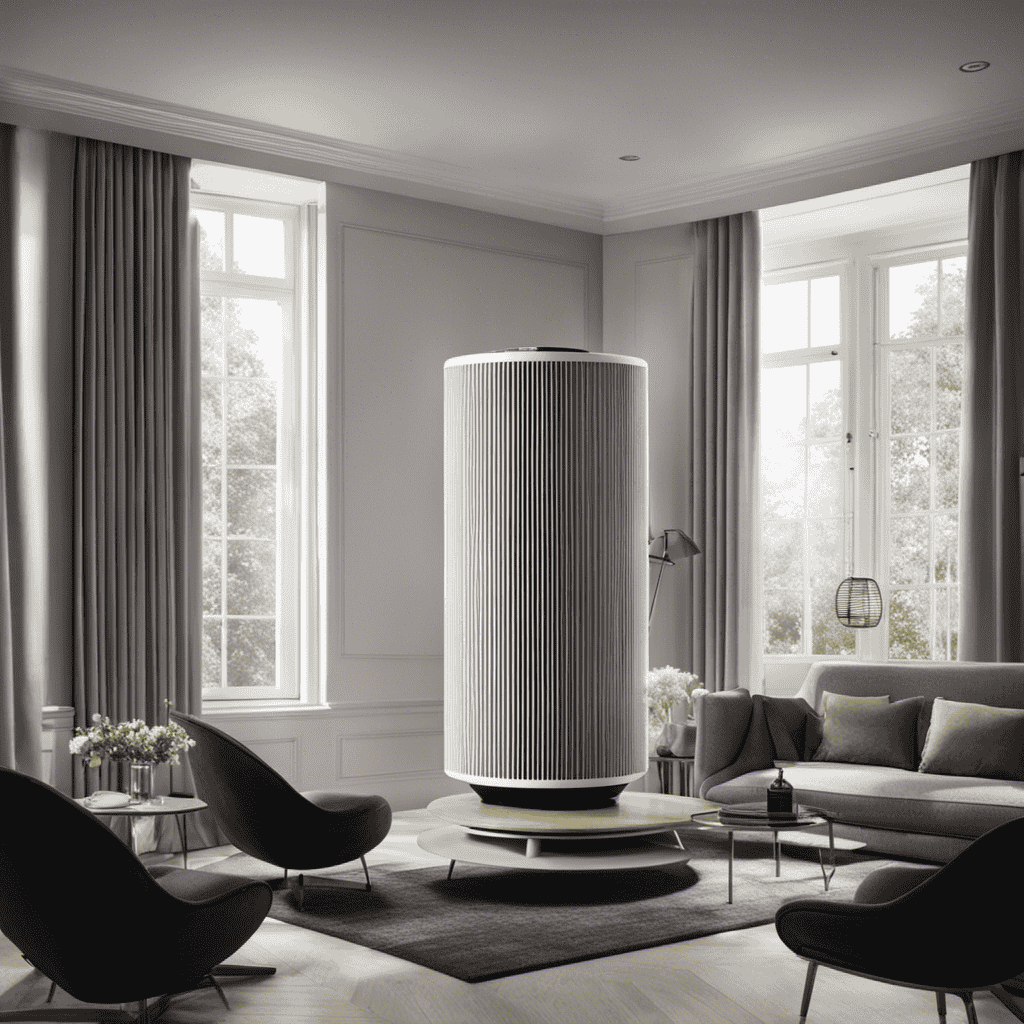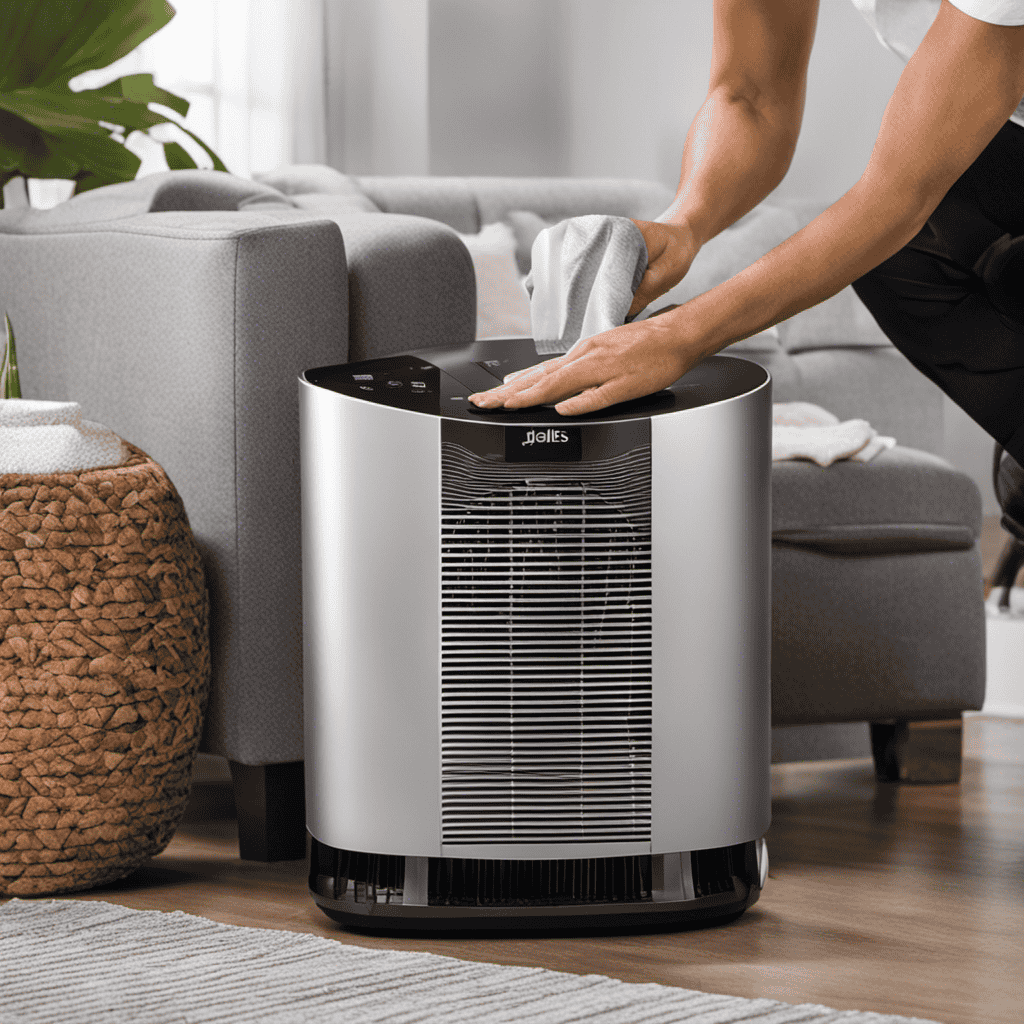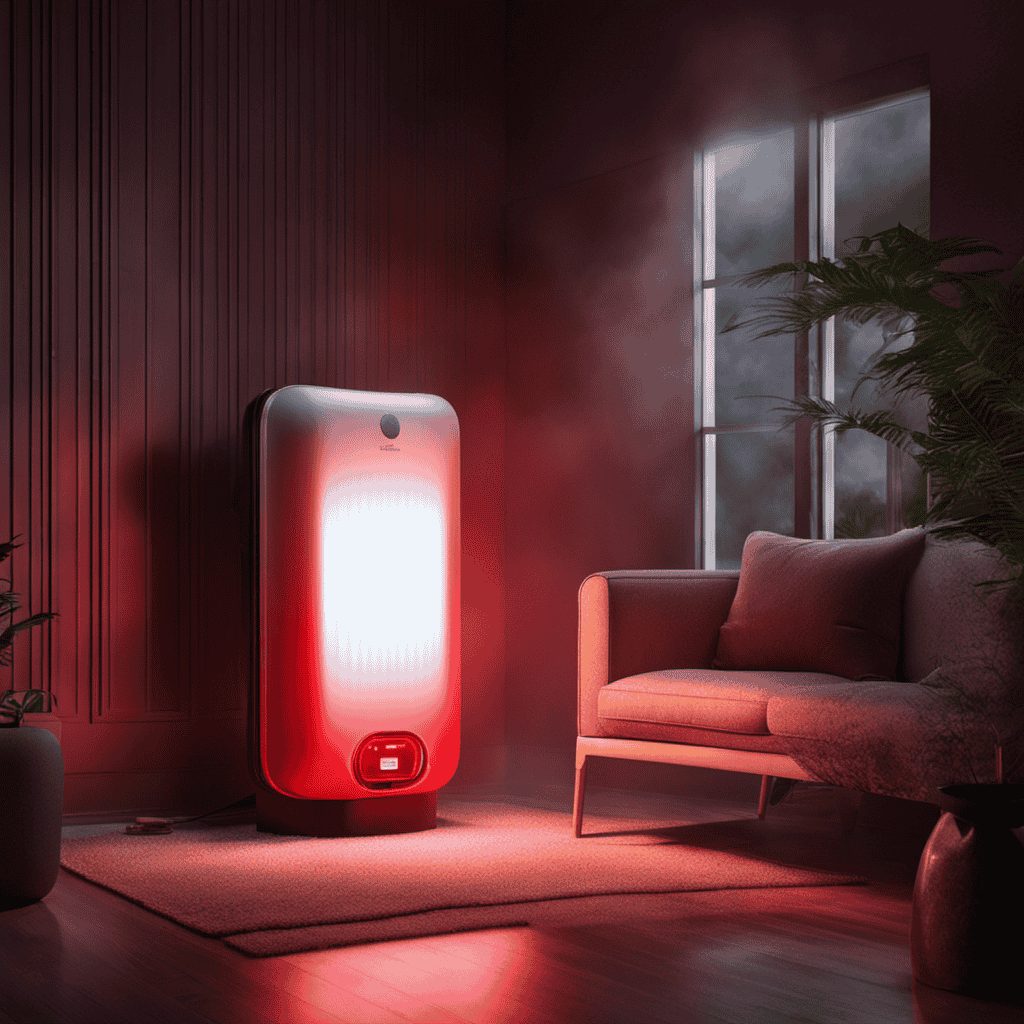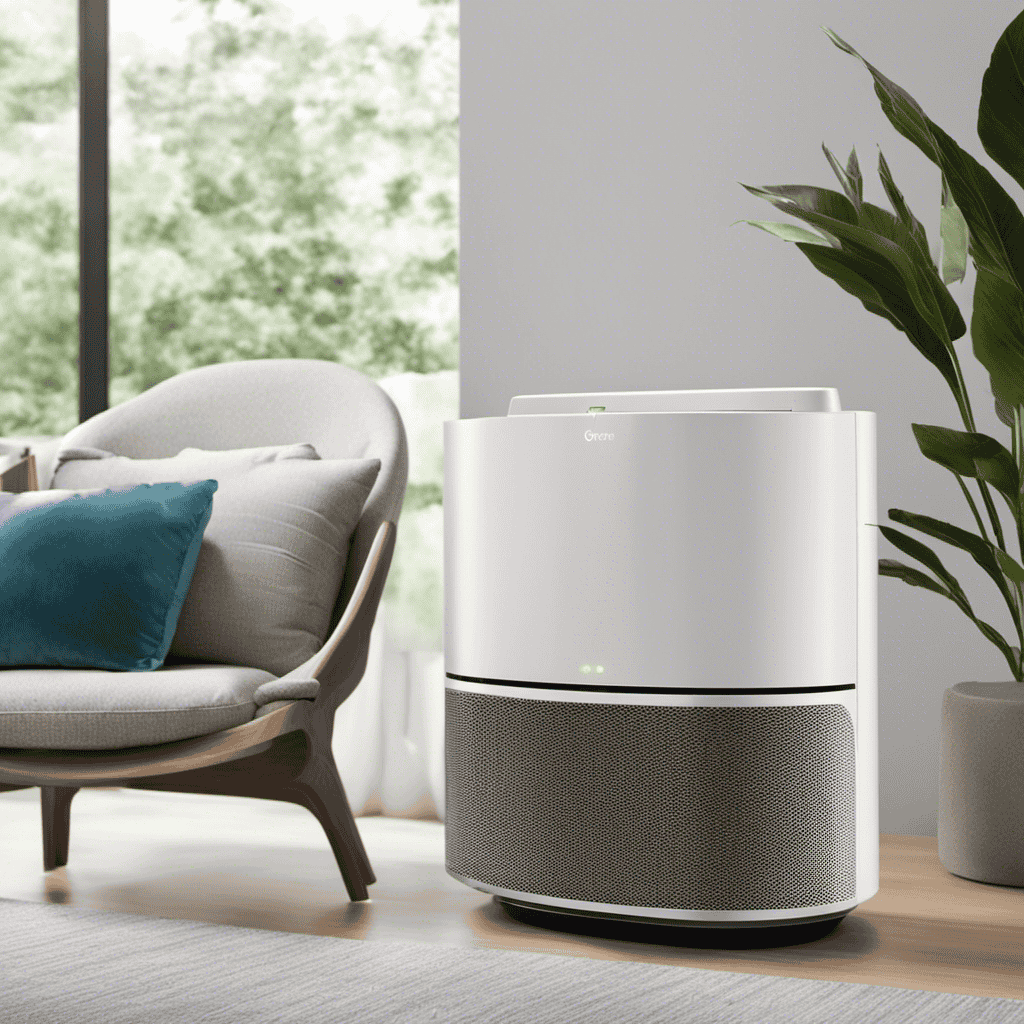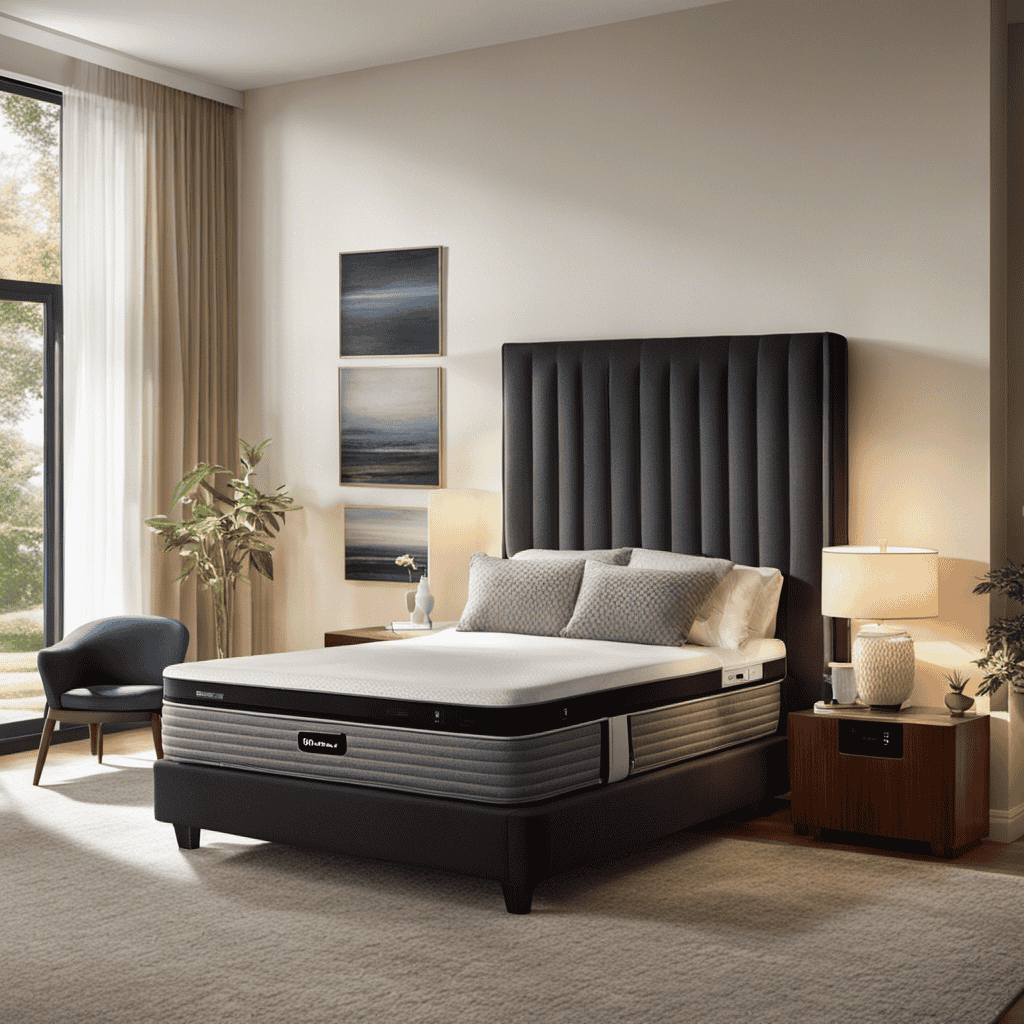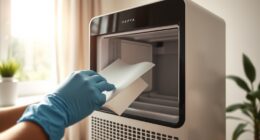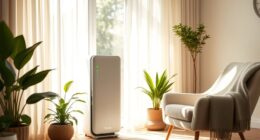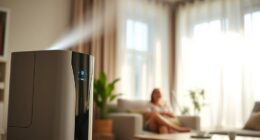As someone who has dealt with the frustrating and harmful effects of smoke infiltrating my home, I understand the importance of finding an effective solution.
In this article, I will guide you through the process of using an air purifier to filter out smoke, ensuring cleaner and healthier indoor air.
We will explore the impact of smoke on indoor air quality, discuss how to choose the right air purifier, and provide tips on positioning, maintenance, and additional air cleaning techniques.
Let’s dive in and discover how we can improve our indoor air quality and breathe easier.
Key Takeaways
- Smoke contains toxic chemicals and fine particles that can be inhaled into the respiratory system.
- Air purifiers with activated carbon filters and HEPA filters are effective in filtering smoke particles.
- Placing the air purifier close to the smoke source ensures quicker and more effective filtration.
- Regular maintenance, including cleaning and replacing filters, is important for optimal performance.
Understanding the Impact of Smoke on Indoor Air Quality
To protect yourself from harmful smoke particles, you should understand how smoke affects the quality of the air inside your home. Smoke can have serious health effects, as it contains a wide range of toxic chemicals and fine particles that can be inhaled into the respiratory system. These particles can irritate the lungs and airways, leading to respiratory issues and exacerbating existing conditions like asthma and allergies.
It is important to have a reliable smoke detection and monitoring system in place to ensure early detection of smoke in your home. This can include smoke alarms and carbon monoxide detectors, which can alert you to the presence of smoke and help you take immediate action.
Regularly checking and maintaining these devices is crucial for your safety and the health of your indoor air quality.
Choosing the Right Air Purifier for Smoke Removal
When it comes to removing smoke from indoor air, there are several methods that can be employed.
One of the most effective ways is by using an air purifier that is specifically designed to filter smoke particles. These purifiers often come with features such as activated carbon filters and HEPA filters, which are known for their ability to efficiently trap and remove smoke particles from the air.
Smoke Removal Methods
You can effectively remove smoke from the air by utilizing various methods. Here are a few options to consider:
-
Regular air purifier maintenance: Cleaning and replacing filters regularly is crucial to ensure optimal performance and efficient smoke removal.
-
Smoke odor elimination: Some air purifiers come with additional features like activated carbon filters or ozone generators that can help eliminate smoke odors, leaving the air fresh and clean.
-
Ventilation and air circulation: Opening windows and using fans can help improve air circulation, allowing smoke particles to disperse and be filtered out more effectively.
By implementing these methods, you can significantly reduce smoke in the air, creating a healthier and more comfortable environment.
However, it’s important to note that while these methods can help eliminate smoke odors, they may not completely filter out all smoke particles. To tackle the issue of filtering smoke particles, let’s explore the next section.
Filtering Smoke Particles
Using activated carbon filters or ozone generators in air purifiers can effectively eliminate smoke odors, leaving the air fresh and clean.
Smoke filtration techniques are essential in reducing smoke odors and improving indoor air quality.
Activated carbon filters are highly effective in removing smoke particles and odors from the air. These filters work by adsorbing the smoke molecules onto the carbon surface, trapping them and preventing them from circulating back into the air.
Ozone generators, on the other hand, work by producing ozone molecules that react with smoke particles, breaking them down and neutralizing the odor. It is important to note that ozone generators should be used with caution, as high levels of ozone can be harmful to human health.
Effective Purifier Features
One of the most effective features of air purifiers is their ability to neutralize unpleasant odors. This is especially useful when it comes to smoke elimination techniques. Air purifiers can effectively remove the lingering smell of smoke from the air, providing a refreshing and clean environment.
Here are some key benefits of air purifiers in purifier maintenance:
-
Improved indoor air quality: Air purifiers can significantly reduce the amount of smoke particles and pollutants in the air, improving the overall air quality.
-
Health benefits: By eliminating smoke particles, air purifiers can reduce the risk of respiratory issues and allergies caused by smoke exposure.
-
Odor elimination: Air purifiers can neutralize and eliminate the smell of smoke, leaving your home smelling fresh and clean.
In the next section, we will discuss the importance of positioning your air purifier for maximum smoke filtration.
Positioning Your Air Purifier for Maximum Smoke Filtration
When it comes to maximizing smoke filtration with an air purifier, optimal placement is key.
Considerations such as smoke flow and proximity to the pollution source play a crucial role in achieving the best results.
Optimal Purifier Placement
To get the best results, it’s important to place the air purifier in the most optimal location to filter out smoke. Here are some key considerations for optimal purifier placement:
-
Proximity to the Source: Placing the purifier as close to the smoke source as possible ensures quicker and more effective filtration.
-
Airflow Direction: Positioning the purifier in the path of the smoke’s airflow helps capture the smoke particles before they spread throughout the room.
-
Obstacle-Free Placement: Avoid obstructing the purifier’s inlet and outlet vents, as it hampers air circulation and reduces its purifying efficiency.
Additionally, choosing the optimal purifier size is crucial for tackling smoke effectively. A purifier with a CADR (Clean Air Delivery Rate) suitable for your room size ensures efficient smoke removal.
Lastly, regular purifier maintenance, such as cleaning or replacing filters, keeps the purifier’s functionality at its peak, ensuring continuous smoke filtration.
Smoke Flow Considerations
Positioning the purifier in the path of the smoke’s airflow helps capture the smoke particles before they spread throughout the room. By understanding the direction of the smoke flow, we can strategically place the air purifier to maximize its effectiveness in filtering out smoke. Smoke detection technology can be used to determine the direction of the smoke flow. This technology utilizes sensors that detect the presence of smoke particles and can provide real-time data on the airflow direction. By analyzing this data, we can identify the areas where the smoke is most likely to travel and position the purifier accordingly.
To illustrate this concept, consider the following table:
| Airflow Direction | |
|---|---|
| Left | Purifier Placement |
| Right | Purifier Placement |
| Up | Purifier Placement |
Proximity to Pollution Source
By placing the purifier closer to the source of pollution, you can effectively reduce the amount of contaminants in the air. Proximity to the pollution source has significant effects on the efficiency of air purifiers in filtering out smoke. When the purifier is positioned near the pollution source, it can capture smoke particles before they disperse further into the surrounding air. This approach helps to prevent the smoke from spreading and causing harm to individuals in the vicinity.
The proximity effects of air purifiers in smoke dispersion are as follows:
-
Improved filtration: Placing the purifier close to the pollution source allows it to effectively trap smoke particles, preventing them from spreading and reducing overall smoke concentration.
-
Faster purification: By being in close proximity to the source, the purifier can quickly remove smoke particles, ensuring a cleaner and healthier environment.
-
Reduced health risks: Proximity to the source of pollution ensures that smoke contaminants are captured before they disperse, minimizing the potential health hazards associated with smoke inhalation.
Maintaining and Cleaning Your Air Purifier’s Filters
Make sure you regularly clean and maintain your air purifier’s filters to ensure they effectively filter out smoke particles.
Maintaining filters is crucial for the optimal functioning of your air purifier. Over time, the filters can become clogged with dust, smoke particles, and other airborne pollutants.
To clean the filters, start by turning off the air purifier and unplugging it from the power source. Remove the filters from the unit according to the manufacturer’s instructions. Depending on the type of filter, you may need to vacuum, wash, or replace it.
For washable filters, gently rinse them with water and allow them to dry completely before reinserting them into the unit.
Regularly cleaning and maintaining your air purifier’s filters will ensure that it continues to effectively filter out smoke particles and maintain clean and healthy indoor air quality.
Enhancing Smoke Removal With Additional Air Cleaning Techniques
To further improve the removal of smoke from your indoor air, you can try incorporating additional air cleaning techniques. In addition to using an air purifier with a HEPA filter, there are other filtration methods that can help reduce smoke odor and improve air quality.
Here are some options to consider:
-
Activated carbon filters: These filters are effective at trapping and absorbing smoke particles and odors, helping to eliminate the smell of smoke in your home.
-
Electrostatic precipitators: These devices use an electric charge to attract and capture smoke particles, preventing them from circulating in the air.
-
UV-C light technology: This method utilizes ultraviolet light to kill bacteria, viruses, and other airborne pollutants, including smoke particles.
Monitoring and Improving Indoor Air Quality After Smoke Exposure
After smoke exposure, it’s important to monitor and improve the quality of the indoor air in your home. Smoke can leave behind harmful particles and pollutants that can linger in the air and affect your respiratory health. To improve air circulation and purify the air naturally, there are several effective methods you can employ. One way is to use natural air purifiers such as plants, which can help filter out toxins and release fresh oxygen. Another method is to open windows and doors to allow fresh air to circulate throughout the house. Additionally, using fans or air purifiers equipped with HEPA filters can help remove smoke particles from the air. Regularly cleaning and vacuuming your home can also help eliminate residual smoke particles and improve indoor air quality.
| Method | Benefits |
|---|---|
| Using plants as purifiers | Filters out toxins and releases fresh oxygen |
| Opening windows and doors | Allows fresh air to circulate and improves air circulation |
| Using fans or air purifiers with HEPA filters | Removes smoke particles from the air |
| Regular cleaning and vacuuming | Eliminates residual smoke particles and improves indoor air quality |
Tips for Preventing Smoke From Entering Your Home
One effective way to prevent smoke from entering your home is by sealing any gaps or cracks in windows and doors. This will help create a barrier and prevent outdoor pollutants, such as cigarette smoke, from infiltrating your indoor environment.
Here are three additional tips to further eliminate cigarette smoke and other outdoor pollutants from your home:
-
Use air purifiers with HEPA filters: These filters are designed to capture and trap small particles, including smoke particles, helping to improve the overall air quality in your home.
-
Maintain a smoke-free environment: Encourage family members and visitors to smoke outside the house to prevent smoke from lingering indoors.
-
Regularly clean and vacuum: Smoke particles can settle on surfaces and in carpets, so regularly cleaning and vacuuming can help remove them and improve indoor air quality.
Frequently Asked Questions
What Are the Long-Term Health Effects of Exposure to Smoke in Indoor Air?
Long-term exposure to smoke in indoor air can have serious health effects. Research findings indicate an increased risk of respiratory problems, cardiovascular disease, and even cancer. It’s important to address this issue to protect our well-being.
Can an Air Purifier Completely Eliminate the Smell of Smoke From a Room?
An air purifier can effectively eliminate the smell of smoke from a room. Regular air purifier maintenance, such as cleaning or replacing the filters, is crucial. Choosing the right air purifier with a strong smoke filtration system is key.
How Often Should I Replace the Filters in My Air Purifier to Effectively Remove Smoke Particles?
To effectively remove smoke particles, I need to replace the filters in my air purifier regularly. By doing so, the purifier can continue to efficiently filter out the harmful smoke particles from the air.
Are There Any Specific Features or Technologies I Should Look for in an Air Purifier to Effectively Filter Out Smoke?
When searching for an air purifier to filter out smoke, it is crucial to consider specific features and technologies. Look for purifiers with HEPA filters, activated carbon filters, and ionizers to effectively remove smoke particles from the air.
Can Using Additional Air Cleaning Techniques, Such as Using Activated Charcoal or Placing Bowls of Vinegar Around the Room, Enhance the Smoke Removal Capabilities of an Air Purifier?
Using essential oils like eucalyptus or lavender to mask smoke smells doesn’t enhance an air purifier’s smoke removal capabilities. However, an air purifier can effectively remove other odors besides smoke, depending on its filtration system and technology.
Conclusion
In conclusion, having an air purifier that effectively filters out smoke is crucial for maintaining good indoor air quality.
After doing extensive research, I realized that choosing the right air purifier is like finding the perfect partner for your lungs. Just like a reliable partner who always has your back, a high-quality air purifier can remove up to 99% of smoke particles, protecting you and your loved ones from the harmful effects of smoke.
So, invest in a good air purifier and breathe in clean, smoke-free air.
